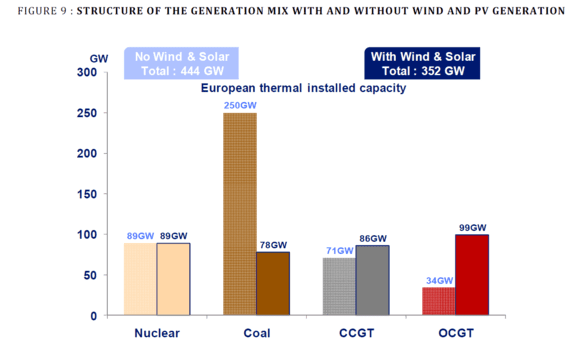In a brief study, the French operator of the country’s nuclear plants unsurprisingly finds that backup generation capacity for fluctuating wind and solar will need to be as flexible as possible. The study also finds that the backup conventional fleet will be smaller.
The 25-page study (PDF in English) published in mid-June investigates what 60 percent renewable electricity would look like, in line with the EU’s current target of 55 percent by 2050. Because hydropower and biomass resources do not have much further potential, the growth will need to come primarily from wind and solar.
Based on experience in Denmark, Germany, Ireland, Portugal, and Spain, the study finds that “the development of wind and PV as a significant impact on power system operation since the system needs to handle the intermittency of these generation sources” (emphasis in original). When wind and solar make up 40 percent of demand (with other renewables making up the remainder towards 60 percent renewable electricity), the remaining conventional generation fleet is smaller.
The study also claims that there would be “limited providers of the ancillary services which are essential for the security of the system.” Yet, battery storage will actually improve system security, wind turbines already provide ancillary services in Germany, and large PV also does. The authors hint at these issues when they write, “The connection of wind farms and PV via power electronic interfaces will lead to a reduction in the inertia of the system.” Yet, they apparently take this reduction in inertia to be an obstacle – the opposite of what studies in Germany have found.
On page 21, the authors state that other options such as demand response and distributed storage “can respond in only a limited way to the needs at a system-level for backup capacity.”
The chart below shows what the generation mix is now (left bars) and in the future (right bars). Note that capacity of combined-cycle gas turbines increases only slightly, whereas open-cycle gas turbines practically triple. As I have pointed out previously, CCGTs are essentially somewhat inflexible baseload plants. The flexible gas turbines everyone talks about are OCGTs.
Finally, on a slightly different topic, the study mentions the reduction in the “market value” of wind and PV at high levels of penetration, an issue that has become a hot topic in recent years.
Overall, the study seems to be a rather conservative view of the future, stressing the limitations and challenges of wind and solar while assuming that nuclear will remain unchanged in the future, with coal capacity being removed instead. In fact, under business as usual, a massive nuclear phaseout is underway in Europe right now; by the mid-2030s, the continent may have only a few nuclear plants still in operation. At the same time, it does not say what a member of Berlin-based think tank Agora Energiewende reads into it: “in 2030 you have no more baseload in Europe.”
Source: Renewables International. Reproduced with permission.










